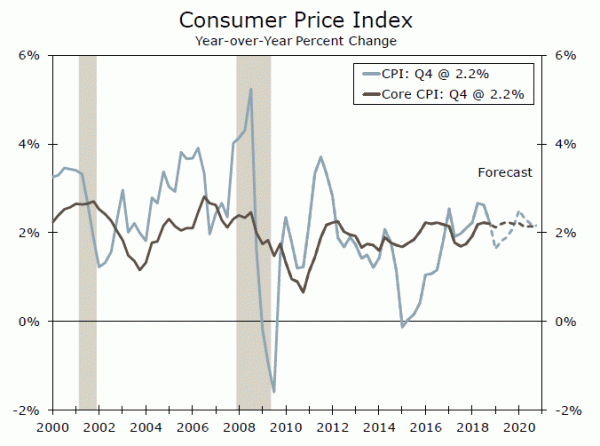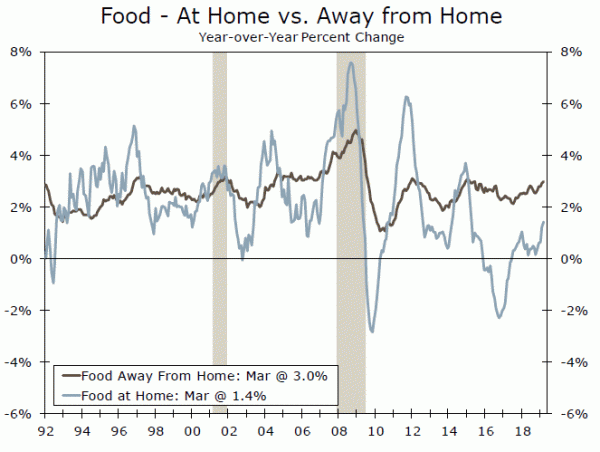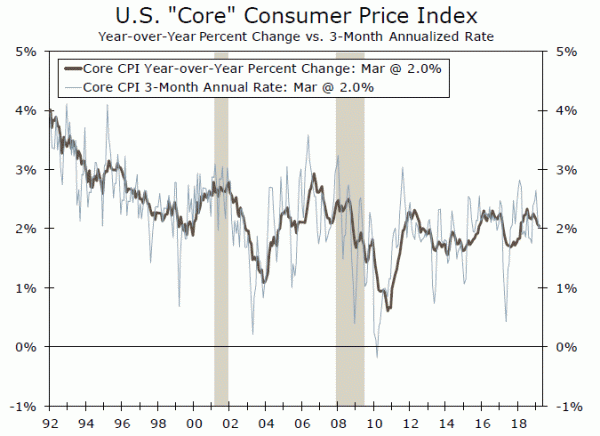The CPI picked up in March as food and gas prices are rising once again. Core CPI inflation softened a touch, due in part to new data methods. But the trend in inflation is likely to remain within the Fed’s comfort zone.
Trend Still Manageable Despite Rising Food and Gas Costs
The latest CPI data show that the trend in inflation remains tame. Core inflation came in a touch softer than expected with the index rising 0.1% (0.148% before rounding). Core goods prices fell 0.2% for a second consecutive month, due, at least in part, to the BLS beginning a new collection procedure that uses actual transactions rather than field surveyors for a department store. For example, apparel prices tumbled 1.9%, the largest monthly drop on record. Core services held up better, increasing 0.3% on another strong gain in shelter costs and a rebound in medical care prices. Nevertheless, core CPI inflation slipped to 2.0% on a year-ago basis and is running at the same rate on a three-month annualized basis, suggesting core inflation is likely to remain near its current run rate.
Overall consumer prices rose 0.4% in March, which was the largest monthly gain in more than a year. A 6.5% jump in gasoline prices was a significant culprit of the increase. We expect oil prices will remain close to current levels over the course of this year and for gasoline prices to exert less sway on headline inflation on a monthly basis as a result. The turnaround in energy prices since December, however, is now pushing total inflation higher again on a year-ago basis. Consumer prices are up 1.9% over the past 12 months compared to 1.5% in February. A pickup in food inflation in recent months also has helped drive the headline index higher. Grocery store prices rose 0.4% last month, while total food prices, including the cost of eating out, are rising at the fastest pace in nearly four years.
Inflation Giving the Fed Breathing Room
We see little risk of inflation moving meaningfully above 2% this year. Slowing growth in the United States and abroad has eased input cost pressures. At the same time, inflation expectations—both short- and longterm— have remained stubbornly low. While an elevated share of businesses report raising prices, low inflation expectations, stronger productivity growth and high margins should limit the magnitude of price hikes.
We have pared down our estimates of inflation later this year as a result. We now look for core CPI inflation to top out over the forecast horizon at 2.2% versus 2.3% previously. Core PCE inflation, the FOMC’s preferred benchmark for its 2% inflation goal, is also likely to take longer than expected to return to target. We expect core PCE inflation to continue to run a touch below 2% this year.
That should allow the Fed to remain “patient” with future rate adjustments. The more cautious tenor from the FOMC lately along with more modest inflation expectations leads us to no longer expect the FOMC to raise the fed funds rate this year. But inflation remains close enough to the Fed’s goal that a rate cut this year—as is currently priced in by markets—looks premature in our view.

















